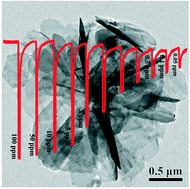Three-dimensional mesoporous ultrathin monometallic cobalt layered double hydroxides nanomaterials as efficient NO2 gas sensor at room temperature†
Abstract
Monometallic cobalt layered double hydroxides (Co-LDHs) were synthesized using a simple hydrothermal method, with 2-methylimidazole (MIm) selected as a functional agent. The functionalization and optimization led to materials, abbreviated as CCM-1, CCM-2, and CCM-3, with remarkable NO2-sensing performance. Representatively, CCM-2 displayed a sensor response of 23.7, response time below 2 seconds, and detection limit as low as 0.05 ppm, as well as good stability at room temperature. The improved performance has been attributed to the three-dimensional mesoporous nanomaterials, which are composed of porous uniform and regular ultrathin nanosheets (about 3.8–5.0 nm thick). The newly-synthesized materials possess large specific surface area and abundant active adsorption sites, and enable to produce more abundant chemisorbed oxygen. Meanwhile, 3D mesoporous nanomaterials with increased layer spacing have constructed an effective channel for electron transmission, promoted the gas-sensing response in the adsorption/desorption path, and shortened the response/recovery time. This work offers a new idea for the synthesis of excellent gas-sensing materials of monometallic Co-LDHs in a facile fabrication way.



 Please wait while we load your content...
Please wait while we load your content...